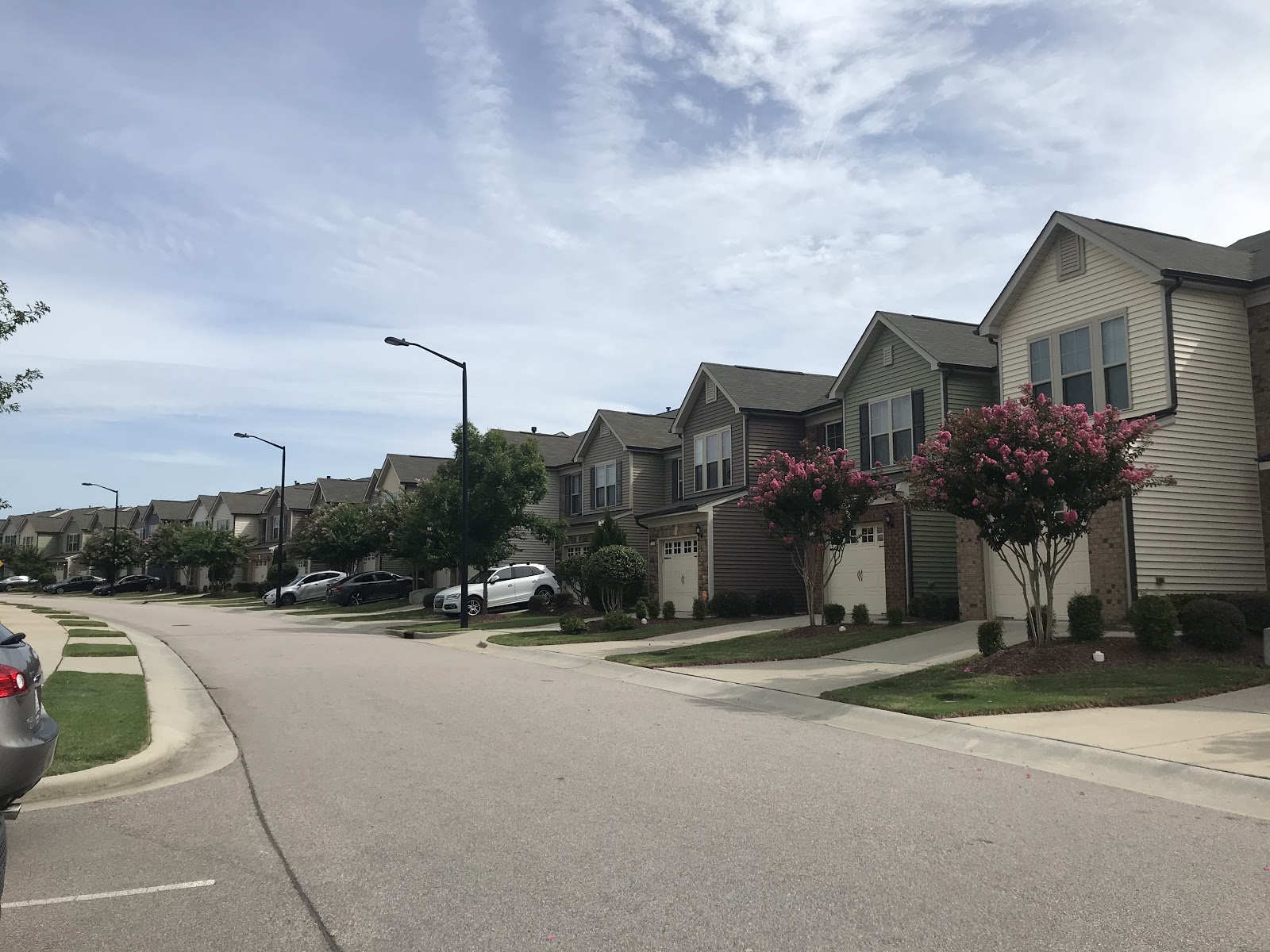Andrew’s Chapel is a sprawling neighborhood on the Wake-Durham County line in Brier Creek. It includes both townhouses and single family homes, giving families different pricing options. (Photo courtesy of Jacob Smith)
The topic of building affordable housing has become as much of a controversial issue in local politics as gun control is in federal politics, but in a time where Raleigh is seeing a population boom, finding enough room for new residents has never been more important.
North Carolina as a whole has seen huge growth in the last decade, adding about a million people since 2010. Much of the growth is a result of northerners moving down to live in bigger cities such as Charlotte and Raleigh. In fact, only 41% of Charlotteans were born in North Carolina. However, the big question that’s left everyone fighting and scratching their heads is, where do all these new residents live?
Some wealthier families have chosen to live in suburbs, but most younger residents looking for sustainable jobs in the area can’t afford to live in the suburbs. They can’t live in the exurbs because that’s too far of a commute, and the inner cities are already jam-packed. The solution many have come up with is to build affordable housing for lower income residents, such as apartments and townhomes. Affordable housing is housing that is low-cost to those with a median household income or below as rated by the national government or a local government by a recognized housing affordability index.
In cities across the United States, we’ve seen local politicians clash over and over on this one issue.
On one side of the spectrum, there are the residents of a city who would prefer lots of development, which would include affordable housing that’s spread throughout the city. On the other side, there are the residents who do not wish to see more development come to their city, or if it has to, have it happen far away from where they live. The former group has earned the title pro-development or YIMBY, which stands for Yes In My Back Yard. The latter group has earned the titles pro-neighborhood or NIMBY, which stands for Not In My Back Yard. While it may seem easy to see pro-neighborhood folks as the bad guys for not supporting lower-income residents, there are healthy points to both sides.
Pro-neighborhood, or NIMBY, activists tend to be on the older and wealthier side. They can afford houses in the cities and suburbs, which tend to reside in affluent neighborhoods. This has led NIMBYs to want to protect their neighborhoods. Lower-income housing usually brings more congestion, traffic, and in some cases, crime. They usually justify their stances by saying they’re trying to preserve the character of the neighborhood.
On the flip side, there are the pro-development or YIMBY activists. YIMBYs tend to be younger, they want their cities to grow and be fun, someplace that makes people want to stay there after college. YIMBYs care less about preserving character and more about creation, whether it be housing, sidewalks, or bike lanes.
In Michigan’s most recent primary, the city of Ann Arbor voted out three NIMBY incumbents, and filled two open seats with YIMBY candidates, creating a 5-0 pro-development council. Here in Raleigh, the city saw a recent shakeup. In last year’s municipal elections, Raleigh voted out three pro-neighborhood council members and elected a strong YIMBY mayor. Raleigh has been seeing exponential growth, but the last council fought on how to handle all the new people. On one side, there was an ideological split on the council so they couldn’t agree on anything, then there were Citizens Advisory Councils.
Since the 1970s, Raleigh has worked alongside Citizens Advisory Councils, or CACs. CACs consist of several different neighborhoods throughout the city, and they had a say in what would happen in their part of the city. “CACs do not hold an opinion. CACs do not oppose rezoning. That is not our job, our job is to be a place so that residents who do oppose the rezoning have someplace to go to have their voices heard,” said Christina Jones, the head of the entire Raleigh Citizens Advisory Council, in a phone interview.
However, when the new council took office, they voted to dismantle that system, taking away CACs’ say in matters. “I don’t one hundred percent disagree with the city council wanting to change [CACs], gutting us the way they did was horrible,” said Jones. In July, a development company introduced a motion to the council to rezone a portion of Shelley Lake Park that would allow for the construction of a hundred condos. A petition opposing the rezoning garnered nearly 9,000 signatures, but the petition fell on deaf ears, the council approved the rezoning 7-1. Before the CAC including Shelley Lake would have had the power to reject the rezoning, but with CACs dissolved, no amount of petition or protest can officially stop any of the council’s decisions.
While the Shelley Lake condos aren’t meant to be affordable housing, it’s a small part of the city council’s attempt to make the city denser, one of the biggest points of conflict that they have with NIMBYs in the city. However, they haven’t been spending their whole tenures approving townhouses and condos. In February, the council approved a rezoning downtown to allow for a forty story high-rise that must include between ten and twenty-five affordable housing units. The council has also put an affordable housing bond on the ballot in November. The bond appropriates $80,000,000 for the council to use to build housing units specifically meant for residents under the median AMI.
The city council has also been working with the county commission to bring more subsidized housing units to the area. The county commission recently got approval to build up to 780 more section 8 housing units, a huge increase from the 563 units that got the green light in 2019. The purpose of this housing will be to provide a mix of senior and family dwellings.
The YIMBY council has been driving through their pro-development agenda since day one of being sworn in, the fast pace change has angered many pro-neighborhood individuals and groups, but the council argues that they’re the only ones bringing solutions to the massive growth problem. As well as trying to handle the growth, the new council has been working to make Raleigh more walkable and accessible.
As it stands now, YIMBYs have the home field advantage. “A lot of people are moving to Raleigh, that’s a good problem to have. It’s a good thing that so many people want to live here and companies want to invest here and increase our tax base so we can provide more goods and services. Let’s welcome the growth and not close the doors to it,” said Melton.
They have the majority on the city council, and they’ve taken away NIMBYs’ only power to stop them.
However, city council terms only last two years, hardly enough time to get much of anything done. “If they continue being pro-development, that’s great. That is not what I have a problem with, I have a problem with them not being able to fulfill their plan… and they should have four years to do it, but next year I could vote them all out and they’d switch back [to pro-neighborhood]. Then what did we do for two years, nothing, we wasted four years,” said Jones. If they stay popular among the citizens of Raleigh, the city could begin to see much more development and growth, but if Raleigh wants to elect NIMBYs again, we’ll be back at square one.

Hi! My name is Jacob Smith and I am a staff writer for The Mycenaean. I am also a political activist and volunteer.

Leave a Reply